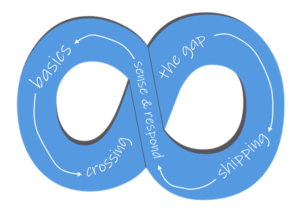Why do we need to learn? Why do we need to be agile? Everything in nature is about evolution and change. If you want any kind of progress, be it economical, societal or technological, you will have to change something or try something new. If you want to change, you will have to adapt. If you have to adapt to a new or changed context, you will have to learn.
So, what does it take to be a learning organisation? To quote Peter Senge, “organisations learn only through individuals who learn”.
What does it take to learn as an individual? What are the key elements of an effective learning process? And how can a learning organisation nurture those elements? Keep on reading to find out.

Four essential components for effective learning
1. Mastering the basics
The ‘basics’ are the building blocks of the craft you want to master, and it’s imperative to invest in learning and improving those basics. Most of the time you can learn the fundamentals of a new competence rather quickly, but it takes time to master the finesses. The pitfall is that once you’re familiar with the fundamentals of a new competence, you already want to jump to the next level. However, don’t forget to continue to work on the basics.
This also applies to a learning company: when the basics are done right, you’re already more than half way there to delight the customer. In reality, when trying to delight the customer – or trying to outperform the competition – the ‘basics’ are often forgotten, and the same is true for your internal employee experience.
2. Mind the gap
The pace of learning is like a yoyo: sometimes progress is fast, sometimes it’s slow. Sometimes you have the feeling of being stuck or even getting worse instead of getting better.
When we start to learn something new, most of the time the first ‘miles’ go smoothly. Yet soon we hit what author Seth Godin calls ‘The Dip’ or what I like to call an ‘improvement gap’. Here, we start to encounter many difficulties and make no real progress for quite some time. This can hit our initial enthusiasm and motivation severely, which often results in quitting. If you hit such a gap, it helps to identify the weak parts of your competences and develop tactical learning techniques to improve them.
3. Shipping – the value in reciprocity and interaction
As Seth Godin puts it, the value is in ‘shipping’, in delivering. An IT project with a development lead-time of two years doesn’t deliver any value during those years.
Value is created in the interaction. If you don’t apply what you have learned and share your knowledge, it has little value. If you do share, the added value is multiplied. You will be able to gain experience and new insights and build the experiences and insights of others. You will be more effective because you have access to more people, knowledge, and opportunities that can help you.
4. Sense and respond
Our environment changes all the time, therefore being adaptive is vital. Instead of end-gaining and trying to rush towards a specific learning objective in a straight line, you will need to be willing to give up achieving your ends by direct means and start using indirect ways.
‘Sense and respond’ is about listening to others, being open for the changing context and using experimentation. Learn by doing, generate results and learn from them, adjust your vision and continue to qualify and develop your competences.
Learning as a balancing act: the DevOps way
As mentioned before, it’s important that you find the right balance between mastering your ‘basics’ and ‘shipping’ regularly. In software development, this is called DevOps and allows to shorten the development life cycle while frequently delivering features, fixes, and updates in close alignment with the business objectives. It’s a process of continuous integrating (shipping), new functionalities and using continuous feedback (sense and respond) in consecutive steps.
 © Jan Dillis
© Jan Dillis
Mastering the basics is an ongoing effort but needs to be alternated regularly with the shipping act in order to be able to sense and respond. Only then you can gain new insights and move forward with an open mindset.
‘Crossing the gap’ illustrates that learning the basics isn’t realised in a straight line. Learning implies coping with loss and frustrations and you learn from stronger and better opponents or from disappointments and failures. Nevertheless, it shouldn’t withhold someone with a growing mindset to step out to connect with others and learn.
